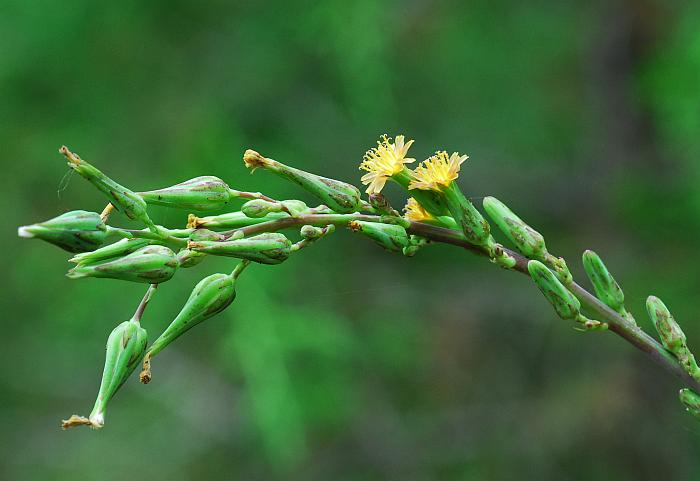Lactuca hirsuta Muhl. ex Nutt.
Downy Lettuce

Native
CC = 4
CW = 5
MOC = 14
© SRTurner
Lactuca hirsuta Muhl. ex Nutt.Downy Lettuce | |
 |
Native CC = 4 CW = 5 MOC = 14 |
© SRTurner |
|
Family - Asteraceae/Cichorieae Habit - Taprooted forb, usually biennial, with tan or pale orange latex. Stem - Ascending to erect, to 2 m, hollow between nodes, glabrous to densely pubescent with long, curled hairs, often purple-streaked.
Leaves - Alternate, deeply pinnatifid and best-developed toward the stem base, reduced in size and often unlobed above the stem midpoint. Basal and lower stem leaves mostly 10-20 cm long, with a winged petiole, ovate or obovate in outline, sharply toothed, the margins sparsely hairy, sometimes with a pair of narrowly to broadly triangular basal lobes clasping the stem, the surfaces usually short-hairy, less commonly only sparsely hairy on the undersurface midvein.
Inflorescence - Usually well-branched panicles with 20-100 heads, occasionally appearing nearly racemose.
Heads - Involucre cylindrical or urn-shaped, 13-20 mm long at flowering, elongating to 15-22 mm at fruiting, the bracts 17. Florets 15-20.
Florets - Ligulate florets with the corollas yellow to orangish yellow or tan, sometimes turning blue with age or upon drying. Pappus 7-10 mm long. Disk florets absent.
Fruits - Achenes with the body 3-5 mm long, 2.0-2.5 mm wide, dark brown to black, flattened, with prominent lateral wings and a conspicuous ridge on each face, tapered abruptly to a slender beak somewhat shorter than to about as long as the body.
Flowering - June - September Habitat - Forests, savannas, sinkhole pond margins, roadsides. Origin - Native to the U.S. Lookalikes - Other members of the genus, especially L. canadensis and L. serriola. Other info. - This species is considered uncommon in Missouri, although there is some possibility that it is more common than generally realized. Due to its strong resemblance to more common species, it may often pass unrecognized in the field and thus be undercollected. Its currently recognized range in Missouri is mostly in the eastern Ozarks. Its North American distribution is widely scattered in the eastern half of the U.S. and parts of Canada. Photographs taken at Millstream Gardens Conservation Area, Madison County, MO, 07-04-2017 (SRTurner) |